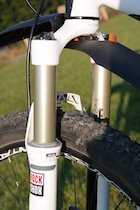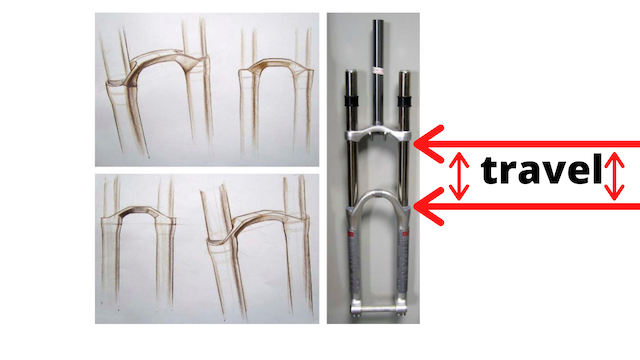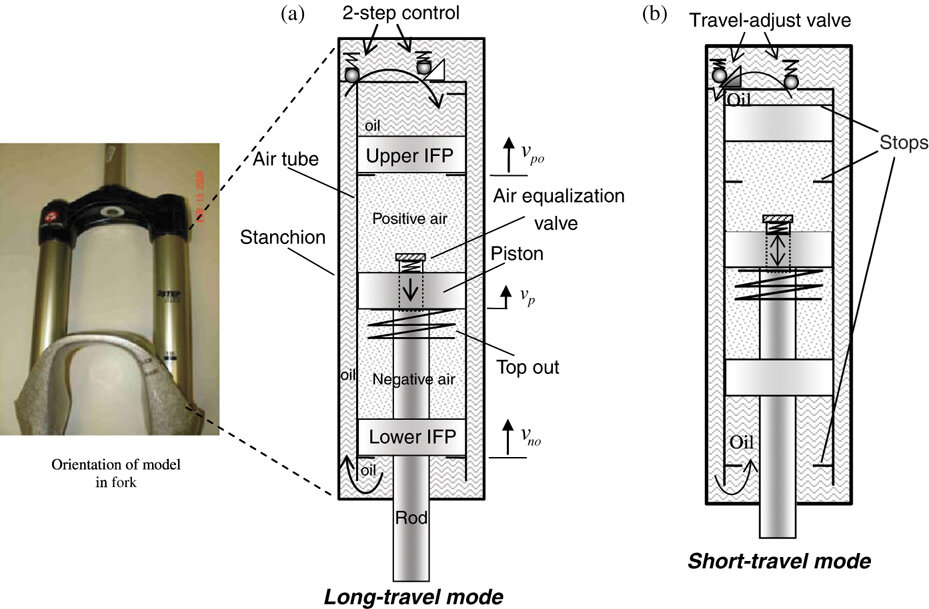What does travel on a mountain bike mean?
Mountain biking travel refers to how far moving parts move or “travel” and is usually measured in millimeters (mm). Travel used to refer specifically to the mountain bike (MTB) suspension, but now also includes the dropper seatpost.
(Image adapted from Baltes et al.)
Two main types of travel
Suspension
Hardtail
Full suspension
Dropper seatpost
What is suspension travel?
(Image Source: (Baltes et al.)
“Travel is the maximum distance that the front or rear suspension can compress before bottoming out.”
What is suspension travel?
Suspension travel refers to how much movement a suspension mechanism allows and is usually a measure of how much the wheel axle moves when the suspension compresses.
Pedal bob and squat refer to how a suspension (usually rear), responds to the rider while pedaling
Squat- Refers to how the suspension compresses under acceleration (As you pedal the bike goes forward, but also the suspension begins to compress)
Anti-squat = resistance to suspension compressions
Pedal bob - Refers to repeated squat and rebounds with each pedal stroke.
Both are undesirable since both bob and squat decrease pedal efficiency and power. (One reason why hardtails are more efficient than full-suspension bikes)
What is sag?
The amount your suspension compresses under your weight is called sag.
Is sag the same as travel?
No. Travel is the distance your suspension moves, while sag is the amount your shocks compress under the weight of your body.
rigid, hardtail & full-suspension & MTB travel
“Bottom out: To hit the bump stop on your suspension unit ”
3 main types of mountain bikes:
Rigid - No suspension system and no ‘travel’
Hardtail - Front suspension fork only
Full suspension - Front suspension fork and rear shock
Short Vs mid vs long & suspension travel
What is the difference between short travel, mid-travel, and long travel?
Travel ranges from about 80 - 220 mm (~3-8 inches) and is trail & terrain & rider dependent. There are some general rules for riding style & front suspension travel:
“Blow through: When a bike uses all its suspension travel, it blows through it”
Short travel: 80 - 120 mm
Cross-Country (XC) MTB
Mid-travel: 120 - 140 mm
Trail riding
Long travel: 150 mm+
All-mountain MTB (140-170 mm)
Downhilling (170 mm+)
What is Damping?
Damping refers to a system that controls (through slowing) the rate of compression in a front-fork shock, or rear shock. This is accomplished by:
Forcing hydraulic fluid (usually oil) through a valve when the shock becomes loaded
Amount of damping determined by:
Resistance through the valve
Greater resistance in the valve = higher amount of damping
Lockout functions usually work by not allowing any hydraulic fluid to flow through the damping valve
Shocks that compress and rebound too quickly will make your MTB bounce like a pogo stick.
travel, stroke & Leverage ratio
When you’re talking with your MTB buddies about suspension travel, you’re talking about the maximum distance that the front or rear suspension can compress before bottoming out. This is the commonly accepted and talked about definition.
However, if you were to talk to a MTB engineer, you would get a different response, since leverage ratio would be a more accurate description of suspension utility:
Stroke is the amount that a rear shock can compress
Leverage ratio is the total rear wheel travel divided by the total shock stroke
High leverage ratio = softer ride
Low leverage ratio = stiffer ride
Suspension systems can be fairly complex, but you don't have to understand all the complexities to enjoy riding singletrack. Understanding the commonly accepted meaning of travel is all that matters when talking about mountain bikes and suspensions for most recreational riders.
How much travel is enough?
How much travel is enough?
This is a common question, but is really hard to answer in general terms due to differences in:
Riding styles
Trails
Terrain
Steepness
Length/Duration
However, there are some general rules of thumb:
Smaller travel = more efficient (less pedal bob and weight): Best for longer rides with minimal technical steep sections like XC MTB
Mid-travel = more versatility: Good all-around trail riding MTB, since they climb and descend technical trails. Nowadays with plus size tubeless tires, you can reduce the tire pressure and get even more out of it for advanced technical terrain
Long travel = less efficient (heavier with increased pedal bob):
All-mountain bikes are designed more for riding steep technical downhill compared to pedaling uphill. However, as bike technology has improved this category of bikes is getting significantly more efficient with uphill and flat pedaling. (Unless you live in areas or ride trails that feature routine sections of steep technical climbs & descents with numerous natural obstacles - MTB’s with long travel is unnecessary for most riders)
Downhill bikes are built only for rough descents in a bike park or other steep and rough terrain. Not designed nor would you want to do pedal on flat terrain, let alone up any hill
What was the 1st full-suspension mtb?
What was the first production full suspension mountain bike?
In 1991 the first full-suspension MTB was produced called the Boulder Gazelle. However, the Boulder Gazelle wasn’t technology advanced enough to handle the rigors of mountain biking
The Specialized FSR (full suspension ride) was the first successful mass produced full suspension bike, which came out around the year 2000
Year of first iPod- 2001
So why do I bring this up? Mountain bike technology is relatively new, with every year bringing more and better components, which means lighter, faster, more efficient and better bikes. Even though bicycles have been around for over 200 years, mountain bike suspensions are barely older than the iPod.
First Fork: In 1989 Rockshox introduced the RS-1, which was the first production mountain bike suspension fork.
What is dropper-post travel?
What is dropper seatpost travel?
Dropper post travel is the distance the saddle (seat) moves from the regular pedaling position to the dropped position for riding technical descents.
Dropper post travel ranges from <60 - 200 mm+
Short travel = <60 to ~ 80 mm
Mid - travel = 80 - 150 mm
Long travel = 150 mm+
Dropper seatpost travel is also rider and trail dependent, but these numbers are general rules of thumb.
Jesse (Director of Pedal Chile) lives in the Chilean Patagonia. I’m an avid MTBer and I enjoy riding both hardtail and full suspension, depending on the trail. Jesse has a Master of Science in Health and Human Performance and a Bachelor of Science in Kinesiology.
Sources & References
Baltes, Jeff, et al. “Development of a Freeride Mountain Bike Suspension Fork.” Sports Technology, vol. 1, no. 2–3, Jan. 2008, pp. 152–165, 10.1080/19346182.2008.9648466.
Clive Forth (2011). The mountain bike skills manual : fitness and skills for every rider. Guilford, Ct: Globe Pequot Press.
Fuss, F.K. (2016). Routledge handbook of sports technology and engineering. London ; New York Routledge.

















